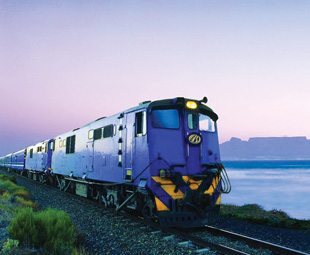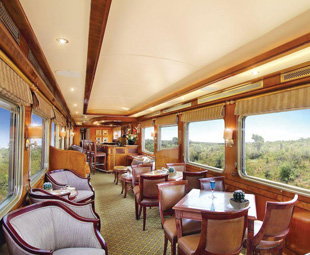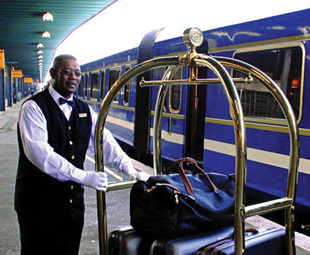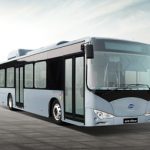How about a “tonnage guarantee”?

South Africa’s famous Blue Train provides some ideas of what can be done to boost local rail transport.
In September 2015, Transnet boss Siyabonga Gama announced a partnership with Sun International that would see the hotel and leisure giant promote the Blue Train to boost its appeal to tourists. Sun International would also contribute the requisite skills to run the enterprise.
According to Gama, Transnet wanted to extend the “reach and footprint” of the “iconic” train, and to increase its occupancy, currently at 70 percent.
Two months later, at the opening of the R800-million renovation of the City Deep Container Terminal, Gama implored the private sector to invest its “lazy cash” into upgrading infrastructure, calling for “concomitant commitment” from captains of industry to lift the economy. (Business Day, November 27).
 It’s always encouraging to see the railway trying out new things and wanting to partner with outsiders. Sadly, as I have pointed out in previous columns, in transport there is usually a gap between theory and reality.
It’s always encouraging to see the railway trying out new things and wanting to partner with outsiders. Sadly, as I have pointed out in previous columns, in transport there is usually a gap between theory and reality.
What became of the Sun City Express, the Sappi “Supplytrain”, the Jacaranda Express, the Daylight Sitter, the Narrow Arrow, the Alfred County Railway and Outeniqua Tjoe-Tjoe?
In 2007, Transnet called for Expressions of Interest from organisations to run the Blue Train. Those who paid a R25 000 non-refundable deposit, would be short-listed. I don’t know how many people lost their money, because nothing ever came of that proposal.
In 2010, Transnet was still running the train and it was trying to sell it to the then recently formed Passenger Rail Agency of South Africa (Prasa) for R1.
At that stage, the annual loss was R65 million. That deal also fell through, although the recent report of the Public Protector suggests that Prasa’s management has certainly been using the train!
By now the deficit must be close to R100 million per year, which is a lot of money to spend on an operation that carries only 6 000 passengers or so each year. I can personally testify that, as a researcher at the railway’s head office (passenger services) in the early 1980s, I started asking questions about the Blue Train’s financial performance, but was politely told to back off.
Can we call for some consistency from both Transnet and its owner, the government? If the underperforming Blue Train and Gautrain can have “patronage guarantees” of R100 million and over R1 billion respectively, how about a “tonnage guarantee” on some lines?
To use Gautrain-speak: rural projects can also “create thousands of jobs and add two percent to the local gross domestic product” – but at a lower cost.
Sadly, a huge repository of institutional memory and grassroots expertise has been stripped out of Spoornet in recent decades. The result is that we have forgotten how to run a daily all-stations train, which is the backbone of any decent railway.
 Nevertheless, Spoornet, itself, has identified about 40-odd lines that could be rehabilitated. These are listed on pages 128 to 136 of its 2013, 30-year, long-term planning framework.
Nevertheless, Spoornet, itself, has identified about 40-odd lines that could be rehabilitated. These are listed on pages 128 to 136 of its 2013, 30-year, long-term planning framework.
One is the Apple Express (Port Elizabeth to Avontuur), which is derelict, but deserves to be revived and declared a world heritage line. Another, surprisingly, is George to Knysna, which, like the Port Shepstone to Harding line (not on the list) is closed. Both closures were attributed to lines being washed away, which should not necessarily be used as an excuse to close any line.
Both lines carried a substantial amount of freight, but also brought in locals and tourists. In 2002, the Knysna line carried over 100 000 passengers, of which 70 percent were foreign tourists. Beat that, Blue Train!
Another line (also not on the list) is Bloemfontein-Ficksburg-Bethlehem. If Transnet can partner with Sun International, why not also have an arrangement with Sandstone Estates near Ficksburg – which has the largest collection of narrow-gauge steam locomotives in the world – to run a regular train on the line?
Sandstone might even be able to organise a steam locomotive to work the train over weekends, which would also probably attract more local and foreign tourists at a lower cost than the Blue Train.
In terms of footprint, reach and corporate social development, such projects will make a stronger impact than running a “health” train.
With an asset base of over R300 billion and total annual income of R61 billion, I suspect that there is enough “lazy cash” lying around in Transnet’s own bank account to start turning rail transport around in South Africa.
Talking of “lazy cash”, I hold a now-worthless share certificate, number 25, in the ACR, the company that worked the Harding line – so much for “concomitant commitment”.
Nevertheless, I wish both Transnet and Sun International good luck with the Blue Train!
Vaughan Mostert lectured on public transport issues at the University of Johannesburg for nearly thirty years. Through Hopping Off, Mostert leaves readers with some parting food for thought as he continues his push for change in the local public transport industry.
Published by
Focus on Transport
focusmagsa




